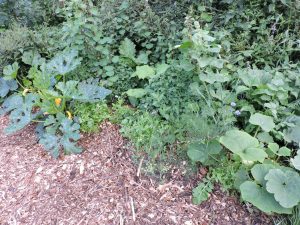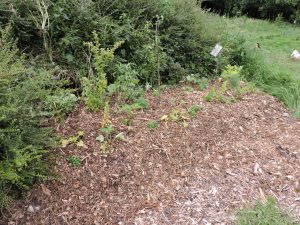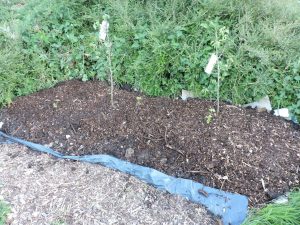We like to turn unused spaces into productive ones. It’s amazing how much can be grown in a 3 by 1 meter garden bed once planted as a polyculture with a variety of vegetable, herbs, flowers and fruit utilizing all the layers of space.
We simply started by putting cardboard on the grass, planted 2 pear trees, then layered compost and then woodchips as a mulch. We planted our little seedlings directly into the bed at this point and once they took off there was no stopping them! Only 6 weeks later the plants filled out the space completely and we are harvesting already. We will have lots of root vegetable in the winter and fruits in years to come from our long term perennials.
Plants used: Pear trees, Glaskin perpetual rhubarb, Oca, Mashua, Yacon, red currant, black currant, sage, angelica, black mallow, marshmallow, strawberries, lovage, dill, fennel, cornflowers, wormwood, pumpkin, courgette and rocket salad.
PLEASE SCROLL DOWN FOR PICTURES
















4 thoughts on “Mini Garden Bed – No Dig – Rapid Growth – VIDEO”
I always thought that wood chips weren’t good to use as a mulch on a productive veg bed as they deplete nitrogen while breaking down? I could be wrong though if everything is doing well for you.
Hi Fran, actually woodchips or any carbonous material applied as a layer of mulch will not deprive the soil of nitrogen unless you mix / plough it into the soil. In fact a good thick layer of mulch protects the soil from the suns UV light, insulates it from cold temperatures and stops the soil from drying in the summer, thus conserving water and energy, as well as the need for digging or weeding. 😀
as long as you add green material, compost or manure, it will be fine. Those materials will prevent the nitrogen depletion that otherwise happen at the second year.
The 4-6inch layer of compost has an excessive amount of nitrogen stored in it. In fact in some places in the gardens we’re growing sunchokes (jerusalem artichokes), these can eat up masses of nitrogen in no time and yet keep expanding year after year. In the forest and in nature in general all fresh organic materials are automatically applied from the top and in layers. The soil life, the insects and the mycelia brake down the usually mostly carbonous material such as leafs and wood slowly with time. The insects and soil life activity help to maintain high nitrogen by them simply pooping and decomposing. We also use nitrogen fixing plants such the legumes like beans etc. Also some trees in places such the locusts.
Comments are closed.